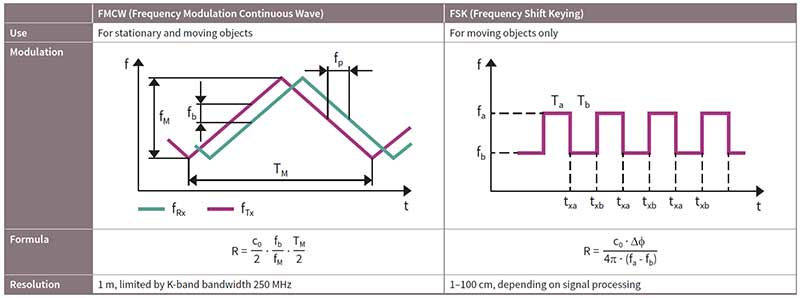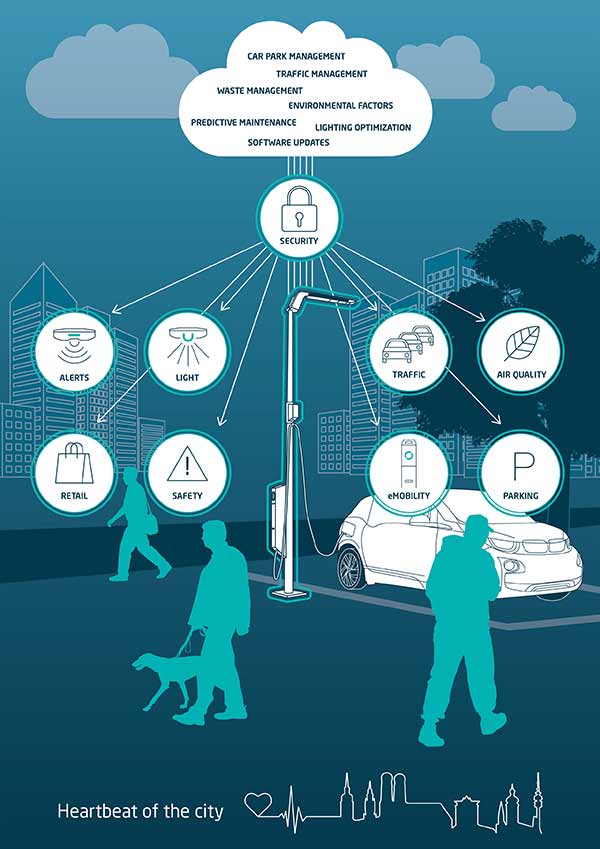Increasing urbanization and access to technology is raising consumer expectations of how convenient our future lives will be. While much of the focus, until now, has been on mobile devices and products, it is now obvious that enhanced infrastructure has a significant role to play in defining and developing the world we live in.
This increased expectation comes with challenges; public administration bodies must develop migration plans while still taking important economic and social issues, such as privacy concerns of citizens and security, into consideration. Designers face increasingly complex challenges with requirements that sometimes compete. On one hand, they are rapidly embracing new technologies to add greater functionality to previously mundane applications such as the humble streetlight while, on the other hand, they are trying to minimize energy consumption in the face of ever-rising energy costs.
In this brave new world, the streetlight is no longer just a light, but is rapidly migrating to become a highly functional and connected portal that forms a key part of smart city infrastructure. However, in order to provide essential functionality and connectivity, lighting designers are now working with cellular connectivity and multiple sensing technologies, both active and passive as well as security solutions.
24 GHz Radar Technology
Radar is an object-detection method that uses radio waves to determine the range, angle or velocity of objects through electromagnetic waves. Typical radar systems consist of several elements including a transmitter that produces electromagnetic pulses or waves in the radio or microwave frequency range, a transmitting antenna, a separate receiving antenna and a receiver that includes the ability to process received signals.
Pulse radar measures the distance of static or moving objects by sending a short, powerful pulse that bounces off the object. The time between the pulse being sent and the received pulse being received is directly proportional to the distance of the object from the radar system.
Continuous wave methods transmit continuously an electromagnetic wave which can be modulated in different ways. FMCW radar (frequency modulated continuous wave) can detect both stationary and moving objects by transmitting a 'chirp' that is mixed with the received signal. The low frequency output represents distance and speed. FSK (Frequency Shift Keying) is used to detect the distance of moving objects. Here, two frequencies are sent sequentially and the phase shifted Doppler signals represent the distance.

Figure 1: Continuous wave radar can detect the position of stationary and moving objects
As detection of objects becomes increasingly important to many smart systems and devices, 24 GHz radar technology is found in multiple applications including multicopters / drones, intelligent door openers, home and factory automation, speed meters, robotics and many other IoT - based applications.
Smart Street Lighting
Recently, Infineon partnered with eluminocity on a project to enable tomorrow's smart, globally connected cities. By combining their know-how and technologies the three companies have developed an advanced and highly efficient LED street lighting application that includes precise sensing capabilities and secure data transmission. The jointly developed smart street light solution is based upon an eluminocity-designed street light that acts as a hub for smart applications. Infineon technology is at the heart of the advanced electronic systems and includes 24 GHz radar, efficient power semiconductors, XMC™ microcontrollers and security solutions from Infineon's highly advanced OPTIGA™ series.
The Infineon OPTIGA™ technology provides an open system that is both highly scalable and fully independent of existing infrastructure and, at the same time, highly secure. The street light operator (often the public administration body) simply needs to ensure the lighting hubs are connected to the already-provided infrastructure.
While the lights themselves are inherently efficient through the application of Infineon's power management and switching devices, the ability of the 24 GHz radar to detect the presence of objects allows light intensity to be increased only when needed, thus providing a far more efficient solution than the most efficient 'always-on' lighting solutions.

Figure 2: Smart lighting is just one function of these intelligent hubs for smart cities
Yet, these eluminocity smart lights are much more than just highly efficient lighting solutions. The proximity detection allows them to detect empty parking spaces nearby which, coupled with connectivity, allows the available space to be communicated instantly to drivers in the vicinity - one element of truly intelligent traffic management. Through monitoring the local traffic conditions, valuable data is available to city planners and shop owners in the surrounding area. The data allows drivers to be guided around areas of congestion, either via control of traffic signals and signs, or through the provision of instantaneous data to on-board satellite navigation systems.
Modern smart lights can also be equipped with electric vehicle charging stations, a key prerequisite to successful electric mobility without occupying additional space.
Smart Lighting: Technology Overview
OPTIGA™ Security Solutions: While these hubs bring highly advanced capabilities to form the backbone of smart cities, the very connectivity that enables the benefits brings potential security weaknesses. In order to address this threat and secure the networks upon which smart cities rely, the lighting hub implements technology from Infineon's OPTIGA™ family of reliable security solutions. These standardized security controllers provide a wide range of security functions for embedded platforms. All OPTIGA™ products are based on Infineon's advanced hardware security technology giving designers and users high levels of confidence in the security. Embedded security functions include system and data integrity, authentication, secured communication, secured data storage and secured updates - all of which are essential to protecting the integrity of future smart cities.
The OPTIGA™ range has a 16-bit state-of-the-art security controller at its heart and can easily be integrated into a wide range of IoT systems. To provide designers full flexibility, the family supports Microsoft Windows, Linux and derivatives as well as providing the integration support for proprietary systems. The OPTIGA™ family also contains TPM devices that are the first to support the very latest TPM 2.0 standard from the TCG, enabling easy implementation of the very latest security protocols.
Smart Proximity Sensing: The proximity detection within the smart lighting hubs is based upon the market's smallest 24 GHz industrial radar chip solution, the BGT24LTR11. This versatile device enables the measurement of multiple parameters including Doppler based object speed / velocity, electromagnetic wave based distance measurements. Additional receive channels also allow detection of angle / direction based upon phase detection at the antennas.
24 GHz offers a high level of precision; up to 50 m for pedestrians and 150 m for vehicles. It is also much more sensitive that the passive infrared (PIR) technology that it will eventually replace in many applications, offering the ability to detect (for example) respiratory movement down to the mm-range. The 24 GHz technology is also able to be operated in a wide range of atmospheric conditions, including significant temperature changes, high levels of humidity and dust thereby making it suitable for outdoor use in even the most inhospitable connected global cities.

Figure 3: Block diagram and package size of the BGT24LTR11N16
For designers that are not yet fully familiar with 24 GHz technology, Infineon offers a set of demokits such as the Sense2GoL demoboard. Alongside the BGT24LTR11 itself, this fully-featured board comes with a XMC1302 ARM® Cortex® M032-bit industrial microcontroller in a compact 25 mm square PCB that also includes dedicated patch antennas for the receive and transmit path. The demoboard is connected to a Segger debugger breakoff board for reprogramming and evaluation.
The comprehensive kit also includes firmware for motion detection and a software GUI for radar signal observation as well as a user manual and full PCB schematics and gerber files for rapidly moving designs into production. Infineon intends to enhance the support for 24 GHz design with the release of reference designs and software configurations in the near future.
Additional Sensing: Almost any sensor can be incorporated into these smart lighting hubs. Gas sensors can monitor air quality and audio sensors can recognize noise pollution levels. Specific use cases could include audio-based vehicle accident or gunshot detection. Although at one level very simple, light sensors play a very important role in making street lighting more intelligent. By detecting ambient light, they can turn the lights on during periods of inclement weather. By monitoring the actual light output, they can provide feedback to the controller to ensure correct light levels are always achieved, irrespective of the aging of the lamp. Wearout data can be provided remotely to technicians to allow better planning of maintenance and alarms can flag any premature failure.
Lighting Controller: The XDPL8220 contains a digital core that enables a variety of systems to be based on the same device. Its advanced control algorithms enable the realization of both constant current, constant voltage and limited power control schemes within the same circuit and it is adaptable to target applications through the adjustment of a comprehensive parameter set.
Compatible with the high expectations of modern power systems, the device offers an input voltage range of 90-305 V AC, an efficiency > 90% and THD < 15%, ensuring compliance with IEC 61000-3-2 class C. An active PFC and harmonic control that functions across a wide output current range ensures a power factor greater than 0.9 in all operating conditions and ensures that additional supply losses due to reactive power and harmonics are minimized.
Summary
Together, Infineon and eluminocity have turned the humble streetlight into a smart and secure hub that will be at the heart of smart city infrastructure. The jointly developed end-to-end solution includes streetlights developed by eluminocity and communications solutions from Intel. The broad range of Infineon solutions includes 24 GHz radar sensors, power semiconductors, microcontrollers and security chips; all elements that make these hubs very versatile.
The open platform enables other stakeholders to make use of the broad sensor networks and innovators are invited to develop new and innovative applications on these systems to support and enhance the globally connected cities of the future.






